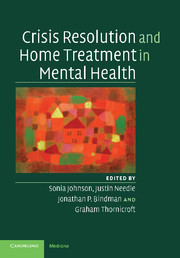Book contents
- Frontmatter
- Contents
- List of contributors
- Foreword
- Acknowledgements
- Section 1 Introduction and concepts
- Section 2 The evidence
- Section 3 Current practice
- Section 4 Variations and enhancements
- 19 Integration of the crisis resolution function within community mental health teams
- 20 Home treatment and ‘hospitality’ within a comprehensive community mental health centre
- 21 Crisis resolution teams and older people
- 22 Integrating day treatment and crisis resolution teams
- 23 Integrating crisis residential care and crisis resolution teams
- Section 5 Developing a local service
- Index
- References
23 - Integrating crisis residential care and crisis resolution teams
from Section 4 - Variations and enhancements
Published online by Cambridge University Press: 13 August 2009
- Frontmatter
- Contents
- List of contributors
- Foreword
- Acknowledgements
- Section 1 Introduction and concepts
- Section 2 The evidence
- Section 3 Current practice
- Section 4 Variations and enhancements
- 19 Integration of the crisis resolution function within community mental health teams
- 20 Home treatment and ‘hospitality’ within a comprehensive community mental health centre
- 21 Crisis resolution teams and older people
- 22 Integrating day treatment and crisis resolution teams
- 23 Integrating crisis residential care and crisis resolution teams
- Section 5 Developing a local service
- Index
- References
Summary
The advantages of treatment at home are described elsewhere in this book and there is substantial evidence that many service users prefer this. Recent English mental health policy reflects this in its central focus on diverting patients from admission by caring for them at home. However, home treatment is not always desirable. In this chapter, the circumstances in which residential acute care is appropriate are identified and the potential advantages of community residential services over hospital inpatient care are discussed. A summary of the development of residential alternatives to hospital is provided. Finally, three examples of how crisis residential care can be integrated with crisis resolution teams (CRTs) are presented and the benefits of such integration discussed.
The need for residential crisis care
Home treatment may be inappropriate in several crisis situations. Risk of harm to self or others may be too great for patients to be left for many hours without staff supervision. People who are severely neglecting themselves, for example by failing to eat and drink properly and care for themselves and their environment in basic ways, are difficult to manage with CRT visits alone. Some have no home or live in very poor circumstances, while others may live in a home environment that exacerbates their difficulties, for example because of an abusive relationship. Another impediment to home treatment is that carers may feel unable to sustain their role in supporting someone at home.
- Type
- Chapter
- Information
- Crisis Resolution and Home Treatment in Mental Health , pp. 283 - 292Publisher: Cambridge University PressPrint publication year: 2008



